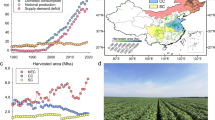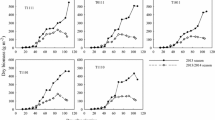Abstract
With the unparallel growth in area and production, soybean has established itself as a leading oilseed crop of India. The crop is mainly grown under rainfed conditions, and the distribution of rainfall plays an important role in yield realization. The changed landform management with broad-bed furrow (BBF) seed drill is gaining popularity as the system helps in in situ moisture conservation and draining out excess rainwater. The economic benefits of the BBF seed drill for the sowing of soybean were assessed using an economic surplus model for the period 2009–2010 to 2024–2025. The yield advantage from the adoption of BBF for the sowing of soybean and improved crop production practices was worked out to be 7.5% over the improved practices with flat-bed sowing and 22.2% over farmers’ practice. The results of analysis revealed that total benefits from the adoption of BBF for the period 2009–2010 to 2024–2025 have been estimated at ₹ 1351.93 lakhs at a discount rate of 5.2% and ₹ 838.74 lakhs at a discount rate of 8% or ₹ 84.50 and ₹ 52.42 lakhs per annum, respectively, with an internal rate of return of 59%. The demonstration of the potential to enhance productivity and farm incomes is an important step in promoting wider adoption of technologies.



Similar content being viewed by others
References
Alston JM, Norton GW, Pardey PG (1998) Science under scarcity: principles and practice for agricultural research evaluation and priority setting. Cornell University Press, Ithaca
Bhatnagar PS, Joshi OP (1999) Soybean in cropping systems in India. Integrated crop management series, plant production and protection division, 3rd edn. FAO, Rome, pp 1–39
Desai NC, Ardeshna RB, and Intwala CG (2000) Increasing pigeonpea productivity by providing land configuration in vertisols. Int Chickpea Pigeonpea Newslett 7:66–67
El-Swaify SA, Pathak P, Rego TJ, Singh S (1985) Soil management for optimized productivity under rainfed conditions in the semi-arid tropics. Adv Soil Sci 1:1–64
GOI (2019) Pocket book of agricultural statistics 2018. Directorate of economics and statistics. Ministry of Agriculture and Farmers Welfare, GOI, New Delhi
Jha AK, Soni M (2013) Weed management by sowing methods and herbicides in soybean. Indian J Weed Sci 45(4):250–252
Joshi OP, Bhatia VS (2003) Stress management in soybean. In: National seminar on “stress management in oilseeds for attaining self-reliance in vegetable oils” held during January 28–30, 2003 at Directorate of Oilseeds Research, Andhra Pradesh, pp 13–25
Joshi PK, Shiyani RL, Bantilan MCS, Pathak P, Nageswara Rao GD (2002) Impact of vertisol technology in India. (In En. Summaries in En, Fr.) impact series no. 10. Patancheru 502 324, Andhra Pradesh, India: International Crops Research Institute for the Semi-Arid Tropics, p. 40
Kampen J (1982) An approach to improved productivity on deep Vertisols. Information bulletin no. 11. International Crop Research Institute for the Semi-Arid Tropics, Patancheru
Mandal KG, Hati KM, Misra AK, Bandyopadhyay KK, Tripathi AK (2013) Land surface modification and crop diversification for enhancing productivity of a Vertisol. Int J Plant Product 7(3):455–472
Motwani S, Ashish (2018) Performance of soybean planted on broad bed furrow system under real farm conditions. Soyb Res 16(1&2):113–117
Nagavallemma KP, Wani SP, Suryanarayana Reddy M, Pathak P (2005) Effect of landform and soil depth on productivity of soybean-based cropping systems and erosion losses in Vertie Inceptisols. Indian J Soil Cons 33(2):132–136
Pathak P, Miranda SM, El-Swaify SA (1985) Improved rainfed farming for semi-arid tropics—implications for soil and water conservation. In: El-Swaify SA, Moldenhauer WC, Andrew L (eds) Soil erosion and conservation. Soil Conservation Society of America, Ankeny, pp 338–354
Patil B, Chorey AB, Deshmukh MR, Karunakar AP (2009) Effect of mulching and land configuration on growth and yield of soybean. Ann Plant Physiol 23(1):86–88
Prasad YG, Maheswari M, Dixit S, Srinivasarao Ch, Sikka AK, Venkateswarlu B, Sudhakar N, Prabhu Kumar S, Singh AK, Gogoi AK, Singh AK, Singh YV, Mishra A (2014) Smart practices and technologies for climate resilient agriculture. Central Research Institute for Dryland Agriculture (ICAR), Hyderabad, p 76
Rama Rao CA, Samuel J, Kumar S, Raju BMK, Dupdal R, Venkateswarlu B (2014) Role of technology and credit in improving farm incomes in rainfed regions of Andhra Pradesh. Agric Econ Res Rev 27(2):187–198
Rama Rao CA, Srinivasa Rao M, Ramakrishna YS, Vittal KPR, Reddy YVR (2003) Economics of some dryland agricultural technologies. Research bulletin SDA-1. Central Research Institute for Dryland Agriculture, Hyderabad
Singh DV, Vyas AK, Gupta GK, Ramteke R, Khan IR (2011) Tractor-drawn broad bed furrow seed drill machine to overcome moisture stress for soybean (Glycine max) in Vertisols. Indian J Agric Sci 81(10):941–944
Singh P, Alagarswamy G, Pathak P, Wani SP, Hoogenboom G, Virmani SM (1999) Soybean-chickpea rotation on Vertic Inceptisols I. Effect of soil depth and landform on light interception, water balance and crop yields. Field Crops Res 63:211–224
Singh P, Pathak P, Wani SP, Srinivas K, Kumar MS, Sudi RS, Jangawad LS (2007) Sustainability of soybean-based cropping systems on a Vertic Inceptisol: 1. Effects of management on runoff, soil erosion, soil fertility and crop yields. Indian J Dryland Agric Res Dev 22:1–14
Singh P, Pathak P, Wani SP, Sahrawat KL (2009) Integrated water resource management for increasing productivity and water use efficiency in the rain-fed areas of India. In: Best-bet options for integrated watershed management proceedings of the comprehensive assessment of watershed programs in India, 25–27 July 2007. ICRISAT Patancheru, Andhra Pradesh, India
Tiwari SP (2014) Raising the yield ceiling in Soybean—an Indian overview. Soyb Res 12(2):1–43
Tomar SS, Tembe GP, Sharma SK, Tomar VS (1996) Studies on some land management practices for increasing agricultural production in Vertisols of Central India. Agric Water Manag 30(1):91–106
Wani SP, Chander G, Sahrawat KL, Pal DK, Pathak P, Pardhasaradhi G, Kamadi PJ (2016) Sustainable use of natural resources for crop intensification and better livelihoods in the rainfed semi-arid tropics of Central India. NJAS Wagening J Life Sci 78:13–19
Author information
Authors and Affiliations
Corresponding author
Additional information
Publisher's Note
Springer Nature remains neutral with regard to jurisdictional claims in published maps and institutional affiliations.
Rights and permissions
About this article
Cite this article
Sharma, P., Dupare, B.U. & Khandekar, N. Economic Impact Assessment of Broad-Bed Furrow Seed Drill for Soybean. Agric Res 9, 392–399 (2020). https://doi.org/10.1007/s40003-019-00444-4
Received:
Accepted:
Published:
Issue Date:
DOI: https://doi.org/10.1007/s40003-019-00444-4




